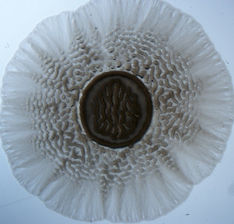
Our research
We are interested in understanding the mechanisms of fundamental biological processes in bacteria. Our lab uses soil bacterium Myxococcus xanthus as the model organism. Several aspects of M. xanthus make it an ideal model for understanding bacterial physiology. First, M. xanthus cells utilize sophisticated systems to move on solid surfaces, which involve cytoplasmic and periplasmic proteins, filamentous cytoskeletons, membrane channels, cell wall, and cell surface components. Second, cells constantly communicate with each other and with their environment. Cells usually move in coordinated groups but also as isolated “adventurous” individuals, which allows this bacterium to feed on soil detritus and prey on other microorganisms. Third, when the availability of nutrients or prey decrease in the environment, most cells exhibit behaviors that include aggregation into fruiting bodies and conversion of individual cells into spores.
Images of M. xanthus

A colony of M. xanthus showing social motility

A M. xanthus warm
Credit: Greg Velicer, ETH
A M. xanthus fruiting body
Credit: Greg Velicer, ETH
M. xanthus (left) prey on E.coli (right)
Credit: James Berleman and John Kirby
Our group has been using the super-resolution photo-activated localization microscopy (PALM) to track single-particle dynamics of proteins in live bacterial cells. With this technique, We have achieved 10 millisecond time resolution (100 frames per second) and 40 nm spatial resolution. These studies were initiated because the most widely used fluorescence microscopy techniques (including confocal, deconvolution, etc.) can only provide resolution to about 200 nm due to the diffraction of light, which is often insufficient for many studies because of the small size of bacterial cells (usually a few hundred nanometers in diameter). Combining genetic approaches with super-resolution imaging techniques, we have made a few major findings on the mechanism of gliding motility and the dynamics of the bacterial cytoskeleton. Our current research projects cover motility, development (sporulation, germination and biofilm formation), cytoskeleton, cell wall assembly and interspecies competition.
